The telecom industry has undergone a significant transformation over the decades, evolving from basic voice communication to complex, data-driven networks that connect the world. This evolution has been greatly accelerated by the integration of Artificial Intelligence (AI). Today, AI in telecom is not just a futuristic concept but a present-day reality that reshapes operations, enhances customer experiences, and drives innovation.
TL;DR
AI adoption in telecom has brought about significant transformations and several advancements in the telecom industry. These include:
- Enhancing network performance
- Optimising network management and operations with AI ensures more reliable and faster services.
- Personalising customer experiences
- AI can tailor interactions and services based on individual customer data.
- Automating customer service
- By using AI chatbots to handle a wide range of customer enquiries.
- Predicting maintenance needs
- AI systems can predict equipment failure to reduce downtime and maintenance costs.
- Preventing fraud
- AI algorithms can detect unusual patterns in network activity, flagging potential fraud attempts in real time.
- Optimising back-office operations
- AI can streamline back-office operations to reduce errors and speed up processes.
The integration of AI leads to:
- improved efficiency
- customer satisfaction
- revenue growth
- innovation
AI Adoption in Telecom
According to Grand View Research, the global AI market size was estimated at USD 196.63 billion in 2023 and is projected to grow at a compound annual growth rate (CAGR) of 36.6% from 2024 to 2030.
The current landscape of AI adoption in telecom shows a rapid increase in the deployment of AI technologies. While AI isn’t new to the telecom space, the release of ChatGPT kickstarted the ensuing boom and race to implement both AI and ChatGPT features to supplement core services.
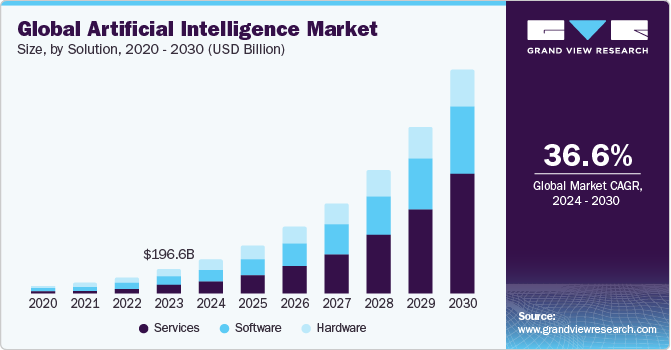 Source: Grand View Research
Source: Grand View Research
In fact, the integration of AI technology is expected to play a key role in accelerating the growth of the global mobile virtual network operator (MVNO) market, which is projected to grow at a CAGR of 7.7% from 2023 to 2030.
Companies are investing heavily in AI to gain a competitive edge and meet the growing demands of consumers and businesses. MVNOs, for example, utilise AI to enhance customer experience, improve efficiency, and streamline operations. However, the specific use of AI varies among MVNOs based on size, resources, and technology investment.
Integrating AI into telecom operations presents both challenges and opportunities. Telecom companies must navigate multiple issues, such as data privacy, the complexity of AI technologies, and the need for skilled personnel. Despite these challenges, the benefits of AI in telecom far outweigh the hurdles, making it a worthwhile investment.
How AI Can Help Mobile Operators – AI Use Cases in Telecom
So, how can AI help Mobile Operators? This section will cover multiple different AI use cases in telecom.
Network Performance Optimisation
AI in telecom is essential for network performance optimisation. Following Ericsson’s Mobile data traffic outlook, the total global mobile data traffic is forecast to grow with a CAGR of around 20% through 2029. It is expected to be an estimated 466 exabytes (EB) per month by the end of 2029.
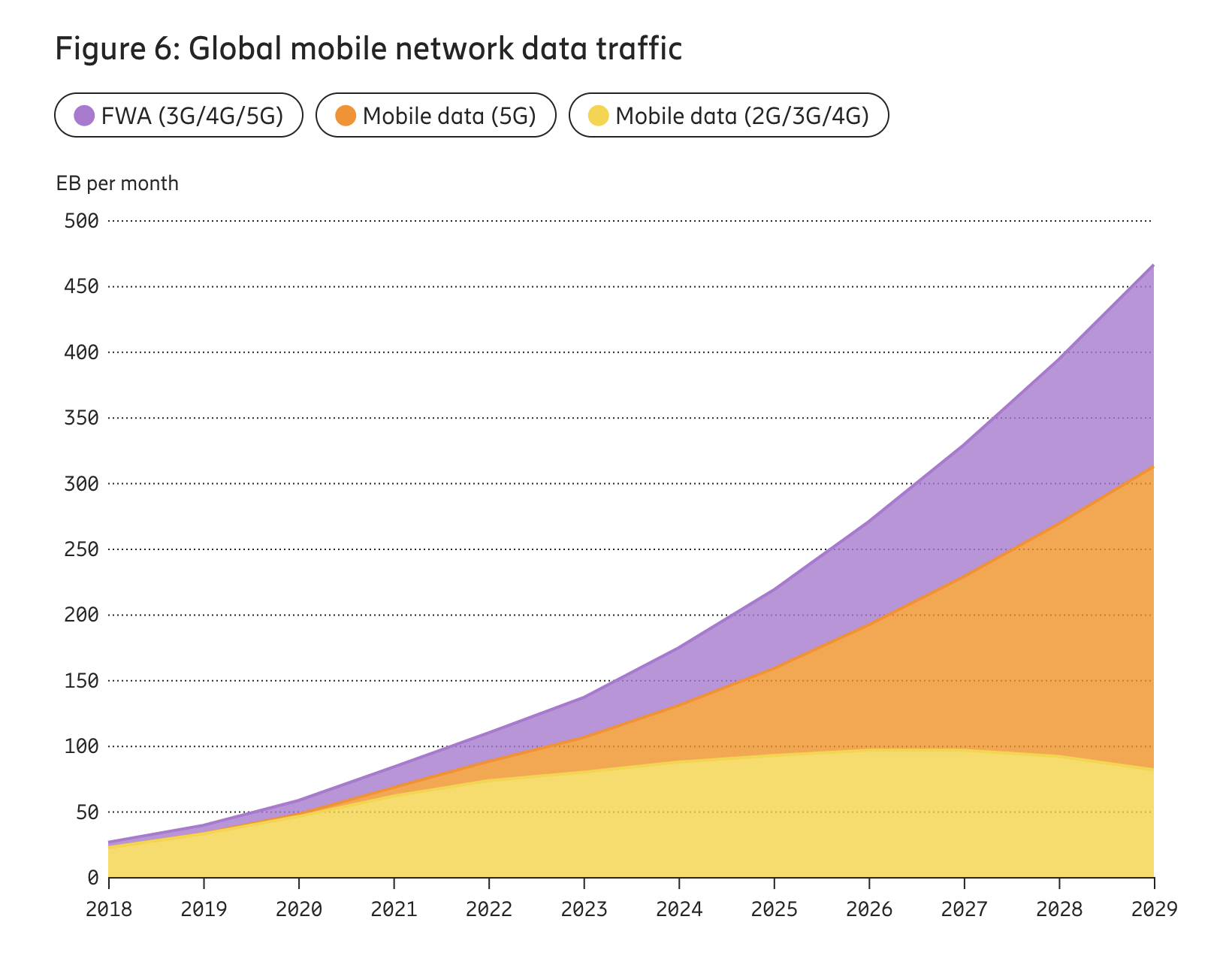 Source: Ericsson
Source: Ericsson
The telecommunications industry is facing a massive increase in global network traffic and a growing demand for network infrastructure thanks to digitalisation in telecom. As a result, network management has become more complex and expensive. AI provides a promising solution to simplify these operations.
AI algorithms can analyse network traffic in real-time, predicting congestion points and automatically rerouting traffic to ensure optimal performance. This can result in fewer dropped calls, faster internet speeds, and a more reliable network.
An example of this is XL Axiata and Ericsson, in which Ericsson aided the Indonesian SP in its radio access network rollout by steering away from traditional drive-test-based initial tuning and acceptance. In 2018, XL Axiata switched from drive testing to Virtual Drive Test, utilising real network traffic data for a fully remote approach, resulting in a 60% quicker site report generation. The Virtual Drive Test used AI-powered, big-data-fuelled geolocation, which involves call trace data collection, processing, and analysis; in turn, it provides visibility of all subscribers everywhere. This helped them maintain a network deployment pace aligned with a 50% CAGR for mobile data traffic.
Personalised Customer Experience
AI has the potential to improve customer experience in telecom through AI-powered recommendations and targeted marketing. Personalising services plays a crucial role in improving telecom customer experience, satisfaction, and loyalty.
Personalisation also has a significant impact on reducing customer churn, introducing relevant new services, and effectively managing the customer lifecycle. For instance, generative AI, or GenAI, enables SPs to create customised marketing campaign content for specific themes and to target individual customers with personalised text and images. GenAI can also be used to support existing customer service operations to create a smoother experience. This in turn can increase ARPU in telecom (average revenue per user).
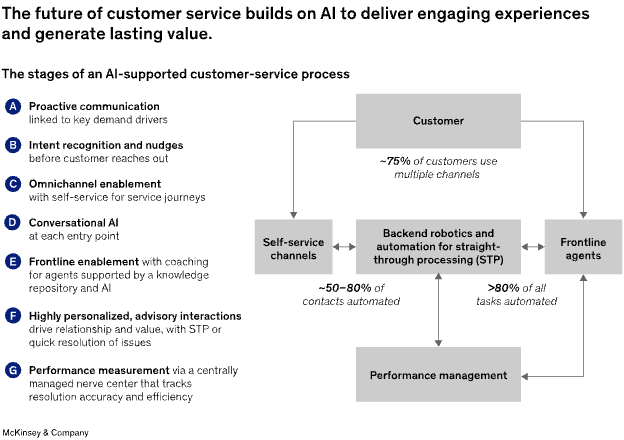 Source: McKinsey & Company
Source: McKinsey & Company
For example, Verizon implemented “human-assisted GenAI technology” to provide personalised support to customers, match them with the best customer care representative, and create tailored experiences. The new tools include a Personal Research Assistant, “Fast Pass” to resolution, Personal Shopper/Problem Solver and “Segment of Me”. This technology will lead to improved answer accuracy, reduced customer transaction time and increased customer engagement.
AI Chatbots for Customer Service Automation
AI chatbots are transforming customer service in telecom industry. These virtual assistants can handle a variety of customer inquiries without human intervention, from billing questions to technical support, providing instant responses and freeing human customer service agents to handle more complex issues. These tools are available 24/7, providing immediate responses to customer queries and reducing wait times.

An example the use of an AI chatbot is Vodafone’s digital assistant, TOBi, to enhance their customer service. It’s designed to help customers manage their accounts and answer most customer queries, all while aiming to improve the customer experience.
As a result of the launch, Vodafone improved customer experience by launching TOBi Sales, the first chatbot in the UK telecoms industry with the ability to complete customer transactions. This innovation reduced checkout time by over 47% and increased the conversion rate from basket to checkout by over 100%. TOBi also significantly improved brand scores, with a net promoter score close to 80.
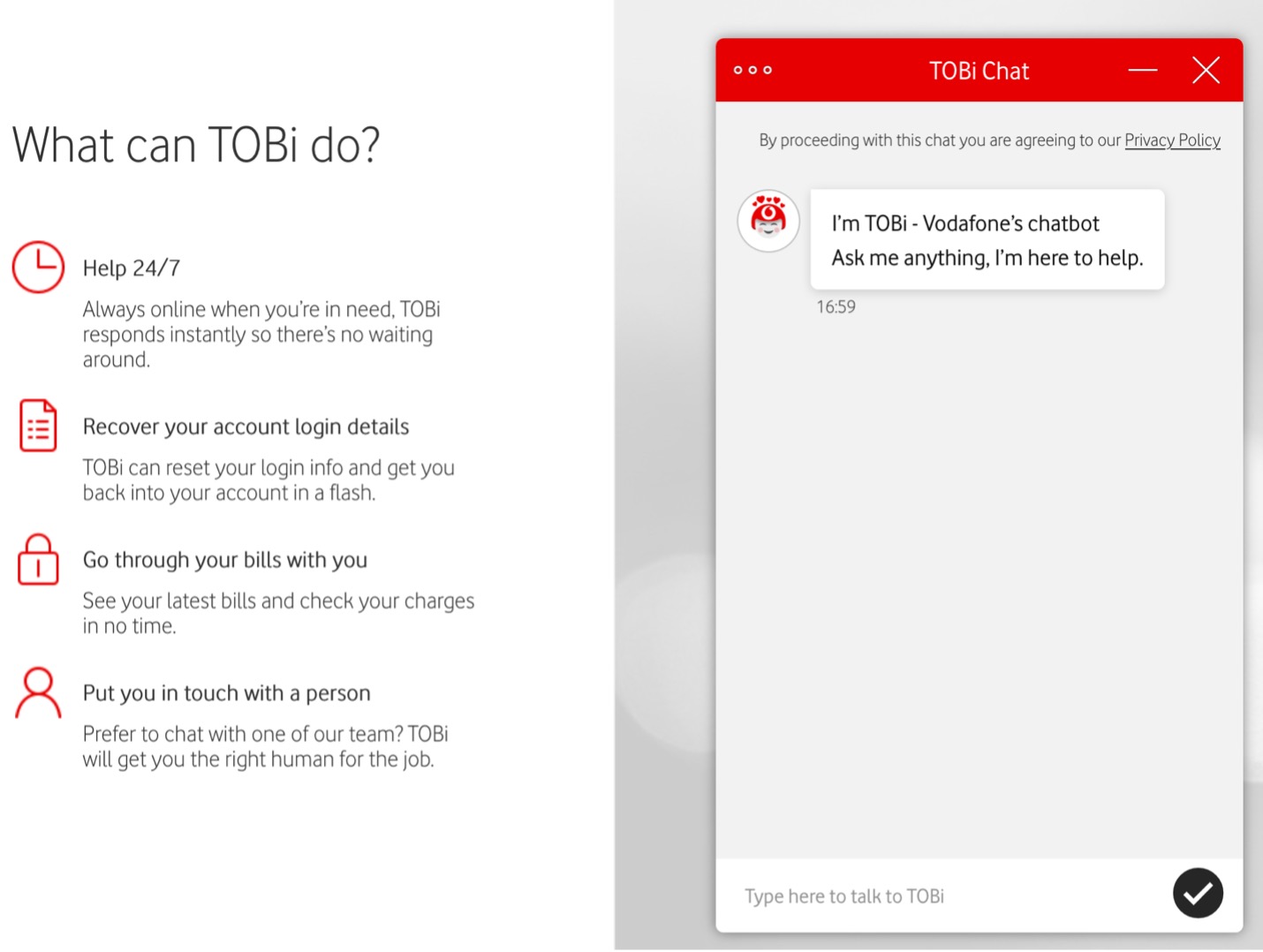 Source: Vodafone
Source: Vodafone
Predictive Maintenance
Predictive maintenance is a highly impactful use case of AI in telecom. By analysing data from network devices and utilising big data analytics for telecom, AI systems are capable of predicting equipment failures before they even happen. This proactive approach results in reduced downtime and maintenance costs, ultimately leading to a more dependable network.
There are four tools that can be used to leverage the full potential of predictive maintenance:
- Data contextualisation
- Data contextualisation presents an opportunity to connect different systems and enable seamless data communication for more organised workflows.
- Reality capture
- Reality Capture solutions offer a digital method for capturing and analysing real-world conditions, providing safer and smarter decision-making.
- Computer vision
- Computer Vision allows for constant monitoring of objects’ conditions, enabling the identification of anomalies and reducing costs, downtime, and safety risks.
- Machine learning
- Machine Learning enables systems to learn from data and make predictions, with significant market growth expected in the coming years.
 Source: Vidya Technology
Source: Vidya Technology
Predictive maintenance uses historical machine performance data to predict when a machine is likely to fail, minimize downtime, and determine the underlying issue. Data Contextualisation provides information to create a 3D model of the operation. Field images are linked to this model using Reality Capture, enabling Computer Vision to detect anomalies like pitting and corrosion using Deep Neural Networks. Additionally, Machine Learning is used to analyse data and understand the current and future state of the operation.
This advanced analytics approach considers thousands of variables and constraints, supporting decision-making more comprehensively than human planners. The benefits of predictive maintenance are significant, including improved uptime, reduced costs, and increased safety. Deloitte’s 2022 report stated that predictive maintenance could reduce facility downtime by 5-15% and increase labour productivity by 5-20%.
This method allows operators to make informed decisions and compare different parameters’ real impact on business outcomes before taking action. In some cases, it may even suggest unconventional actions to enhance productivity or profitability.
Automation of Back-Office Operations
AI has become instrumental in revolutionising back-office operations in the telecoms industry. SPs are harnessing the power of AI to streamline and optimise processes related to billing, invoicing, and inventory management. By implementing automation, companies can significantly reduce errors and operational costs, while simultaneously accelerating the speed of these critical processes. This, in turn, allows telecom companies to redirect their resources towards more strategic activities, driving greater business growth and development.
The result is a considerable reduction in overhead costs and more effective planning. By boosting financial efficiency, companies can achieve a higher return on investment (ROI) and allocate more funds towards capital expenditure (capex) investments. Ultimately, this leads to increased customer satisfaction as companies are able to enhance their products and services with the improved resources at their disposal.
According to Transforma Insights, the robotic process automation (RPA) market is predicted to surpass $13 billion by 2030, an increase of more than $12 billion compared to 2020. RPA entails utilising software robots or bots to automate mundane business tasks, which accelerates enterprise operations and reduces expenses.
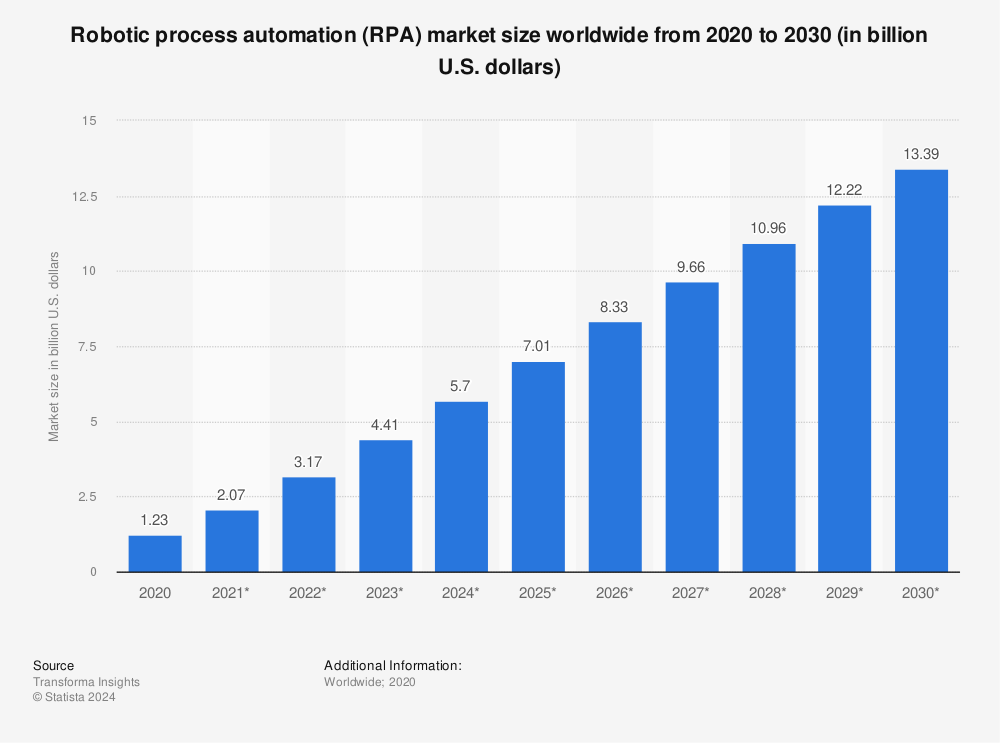 Source: Statista
Source: Statista
WCTel worked with TechSee during the COVID-19 pandemic, in which technicians struggled to service subscribers with the ongoing lockdown restrictions. TechSee aided in reducing the technician dispatch rate by 16-20% and increased the rate of first contact resolution.
Fraud Prevention
AI in telecom is instrumental in fraud prevention. According to Juniper Research, it’s predicted the global merchant losses from online payment fraud reached $38 billion in 2023.
There are several different methods that AI tools could be used to commit fraud and scams, which can potentially increase the volume and sophistication of fraudulent activities:
- Generating text and image content.
- AI technology can be misused to create deceptive content, like emails and images, to trick people in scams or fraudulent activities. AI can also be used to make fake images for insurance claims. Although some AI tools have safety measures, they can be bypassed, and open-source models could be used for malicious purposes.
- AI-enabled chatbots.
- Some organisations have found evidence of scammers using advanced chatbots, potentially powered by AI, to manipulate people into making payments. Chatbots could automate scams on a large scale and become indistinguishable from human interaction, making detection harder over time.
- Deepfake videos
- Deepfake videos are being used to trick people into visiting malicious websites and stealing card details. Trusted individuals’ images and identities are also being used to lure people into engaging with harmful content. Some individuals have tried to use deepfake videos to bypass security measures. Experts predict that deepfake use will increase, and technology and behavioural changes will be necessary to help people tell trustworthy content from untrustworthy content.
- Voice cloning
- Deep fake technology is advancing quickly, allowing for highly accurate voice clones with less training data. It may soon be possible to create indistinguishable human voice clones from just seconds of audio. This technology is already being used in scams, including real-time conversations with scammers using cloned voices, posing a significant fraud risk. For example, scammers could impersonate a telco customer service representative and request unauthorised payments.
- Targeting of victims
- AI tools can be used to gather a lot of information about individuals and personalise scam messages specifically targeting their vulnerabilities. This kind of tailoring, known as ‘spearfishing’, isn’t new, but the ability to do it on a large scale automatically is a rising concern.
- Pressure testing
- There has been a rise in sophisticated brute force attacks, particularly on debit and credit cards. As AI advances, it’s anticipated that these attacks will become even more sophisticated, and AI will be used to identify and exploit vulnerabilities.
According to a report by PwC, there are three key roles that AI plays in the prevention of fraud and scams.
- Firstly, it can improve detection capabilities by using machine learning (ML) and other AI approaches to identify patterns of fraudulent behaviour.
- Second, AI can free up human resources by handling simple tasks like customer queries, allowing experts to focus on more complex issues, such as fraud cases.
- Finally, AI tools are also being developed to help identify fake content and proactively protect users from scams.
American Express partnered with NVIDIA to improve fraud detection accuracy by 6% with deep learning models. This implementation enabled a real-time fraud detection system that increased accuracy and enhanced the protection of both customers and merchants.
Benefits of AI in Telecom
The integration of AI in the telecom industry offers a multitude of benefits that can significantly enhance various aspects of operations and services. These benefits include:
1. Improved Operational Efficiency and Cost Reduction
- Streamlined Processes: AI automates routine tasks such as network management, monitoring, and maintenance, which reduces the workload on human employees and minimises the chances of human error.
- According to Veritis, predictive AI-powered maintenance has the potential to decrease downtime by as much as 40%, thus substantially enhancing network reliability.
- Cost Reduction: By optimising resource allocation and reducing the need for manual interventions, AI helps in cutting down operational costs. Predictive maintenance powered by AI can also prevent costly outages and extend the lifespan of equipment.
- According to Deloitte, predictive maintenance can increase productivity by 25%, reduce breakdowns by 70% and lower maintenance costs by 25% on average.
2. Enhanced Customer Satisfaction and Loyalty
- Personalised Services: AI-driven analytics can create detailed customer profiles that allow telecom companies to offer personalised services and recommendations, enhancing the user experience.
- Efficient Customer Support: AI-powered chatbots and virtual assistants provide 24/7 customer support, handling common queries and issues swiftly, which leads to higher customer satisfaction and loyalty.
- A study by Tidio has found that up to 62% of customers prefer using a chatbot over speaking to a human agent if it’s quicker, which is often the case. They can escalate more complex issues to human agents, ensuring that customers always receive the level of care they need. Ultimately, AI chatbots have the potential to significantly enhance the user experience by speeding up and improving the accuracy of service request responses.
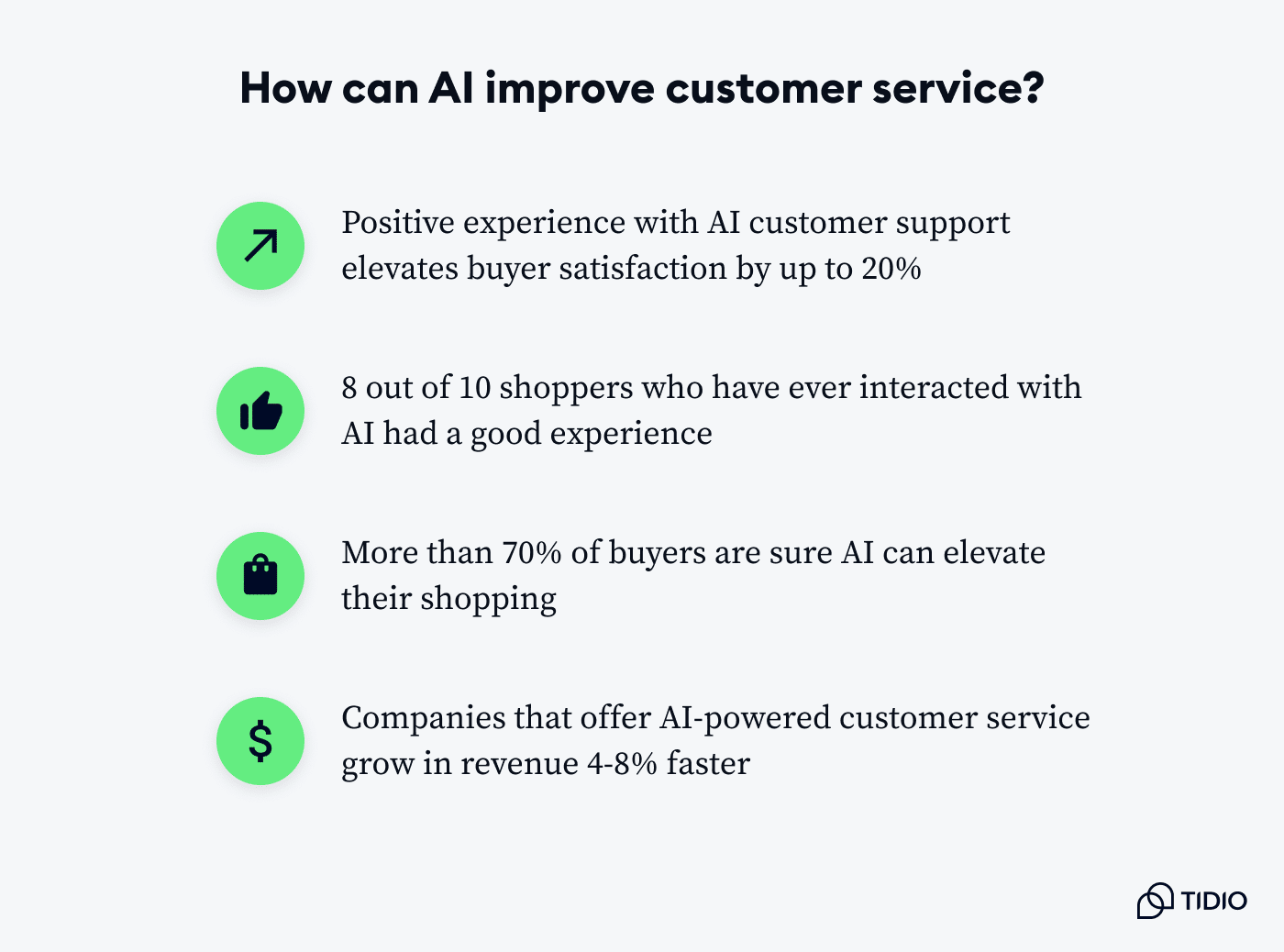 Source: Tidio
Source: Tidio
- According to Salesforce, 84% of consumers believe that being treated as individuals rather than just numbers is essential to preventing customer attrition. Not only that, but 80% of customers say the experience a company provides is as important as its products and services.
- By analysing customer data, AI can anticipate user preferences and recommend relevant products and services, ultimately boosting customer satisfaction and loyalty.
 Source: Salesforce
Source: Salesforce
- Furthermore, research shows that 76% of customers are willing to share their data with operators in order to receive personalised recommendations tailored to their specific needs and preferences. Additionally, 59% of customers are open to spending more in order to receive a plan that is customised to their specific requirements across voice, data, entertainment, and other personalised services.
3. Increased Revenue Generation Opportunities
- Targeted Marketing: AI enables precise targeting of marketing campaigns based on customer data and behaviour analysis, increasing the chances of conversion and boosting sales.
- Optimised Service Offerings: By analysing usage patterns and preferences, AI helps telecom companies develop and offer tailored service packages that meet the specific needs of different customer segments, thus creating new revenue streams.
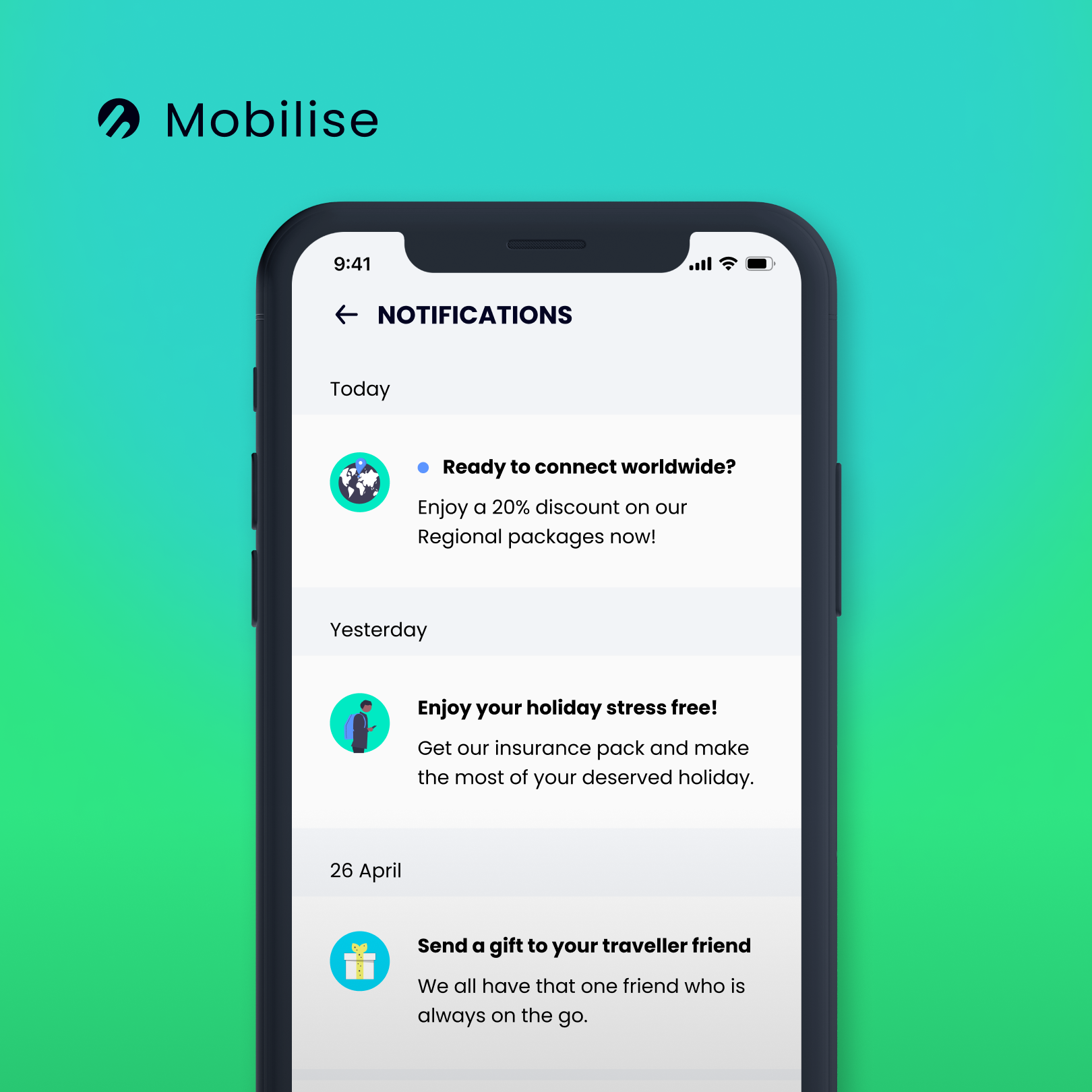
4. Accelerated Innovation and Agility
- Rapid Response to Market Demands: AI allows telecom companies to quickly adapt to changing market conditions and customer demands by providing real-time insights and predictive analytics.
- Technological Advancements: AI helps in the rapid deployment of new technologies and services, ensuring that telecom companies stay ahead of the competition and can offer cutting-edge solutions to their customers.
5. Facilitation of Data-Driven Decision-Making
- Valuable Insights: AI analyses vast amounts of data to uncover trends, patterns, and insights that can inform strategic decisions and operational improvements.
- Strategic Planning: With accurate data-driven insights, telcos can engage in more effective strategic planning, ensuring sustainable growth and long-term success.
The Future of AI in the Telecom Industry
It’s clear that the future of telecom industry is promising, with emerging trends and technologies set to further transform the industry. Advances in AI, such as ML, edge computing, generative AI and 5G networks, will enable even more sophisticated applications, from real-time language translation to autonomous network management.
The current landscape of AI adoption in telecom shows a rapid increase in the deployment and integration of AI. Valuates predicts that the size of the global AI in telecom market will amount to $19170 million by 2030. Telcos are investing heavily in AI to gain a competitive edge and meet the growing demands of consumers and businesses. While integrating AI into operations presents challenges, the benefits of AI in telecom far outweigh the hurdles and produce tangible results, making it a worthwhile investment.
Conclusion
AI in telecom isn’t just a trend but a fundamental shift in how the industry operates. By leveraging AI, telecom companies can optimise network performance, enhance customer experiences, automate operations, and stay ahead of the competition. The future of AI in telecom holds immense potential, promising a more connected, efficient, and innovative industry.



